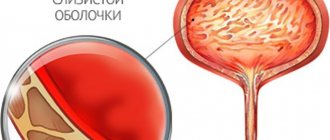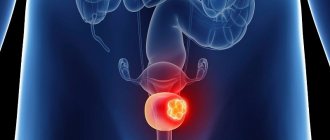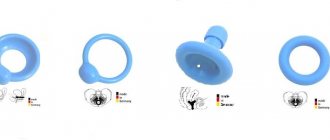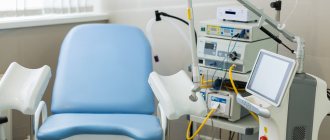We receive a large number of questions on this topic in the comments to all our videos, which are devoted to anatomy and physiology, and pelvic floor surgery. When you address this issue on Youtube, social networks or make a request in search engines, you come across so many different resources that carry such an abundance of sometimes crazy information that this creates various associations in the blooming minds of the audience, a craving for experimentation, hopes and subsequent disappointments. Therefore, we decided to provide here information from the field of evidence-based medicine, the field of clinical practice, that is, the reality that you will have to face one way or another.
Exercises for prolapse of the uterus for the vaginal muscles
The first thing you start with these exercises is squeezing and relaxing the anal sphincter. When pulling up the anus and relaxing it, you should not try too hard so as not to overstrain the muscle. After a few days of dosed training, contraction and relaxation of the onion-cavernosus muscle, covering the entrance to the vagina, is included.
It is important to follow the correct breathing technique - push the muscles of the pelvic floor with the lower abdomen, drawing it in and holding your breath. This is difficult only at first; once you master uniform and correct breathing, the combination of breathing with exercises will be easy.
You need to inhale through your nose and exhale through your mouth, opening it slightly. Breathing should be even, calm, and unhurried. The volume of training and the number of approaches increase gradually. Be sure to take into account the features of performing Kegel exercises:
- "Interrupt".
To determine which muscle to use during this exercise, you can practice while urinating. By contracting the bulbocavernosus muscle, a woman stops the flow of urine. By interrupting the flow of the stream 3-4 times in one approach, you cannot engage the muscles of the peritoneum and buttocks, you need to monitor your breathing. After identifying the muscle that needs contraction, you need to train outside the act of urination. At the same time, the muscles of the anus are contracted, that is, interruption is performed with emphasis on both muscles.
- "Slow Compression"
The technique for performing this exercise is similar to the previous one, only compression and relaxation follow a certain algorithm. You should take a lying position and carefully monitor your own breathing.
Kegel compression options:
- Cycles of compression and relaxation take 15-20 seconds, repeat 10 times;
- Cycles of compression and relaxation occur under the slow count of “one, two, three”, repeat 15-20 times;
- Muscles contract for 5 seconds, relax for 10 seconds, repeat 7 times. Next, squeeze the muscles for 5 seconds, and relax them for 5 seconds, repeat 3 times. After 3 similar approaches, do the following - squeeze and relax the muscles for 30 seconds, repeat 3 times. After this, return to the initial cycle of compression and relaxation.
- "Floors".
The slow contraction of the muscles in this exercise engages the outer and inner layers of the pelvic floor muscles.
Sequence of the exercise:
- Squeeze your external pelvic floor muscles for a few seconds.
- Increase compression strength by engaging the middle muscle layer.
- On the count of “one, two, three”, tense the muscles of the pelvic floor with maximum effort, involving the inner muscle layer.
- Abbreviations.
This exercise differs in the speed of compression and relaxation. However, even at the highest possible speed, the rhythm of breathing should not be disrupted. Relaxation occurs on exhalation, and contraction occurs on inhalation. Intermittent and monotonous breathing is a sign of violation of the exercise.
- Popping and flashing.
This exercise uses the muscles that respond to the ability to push. When the uterus prolapses, it is performed in a supine position. When pushing, a woman lingers at the maximum point of relaxation and compression for as long as possible. It is optimal if up to 10 approaches are performed.
Upon reaching the “top floor” you need to try to hold this position for 5 seconds. Relaxation occurs in the reverse order - first the inner layer relaxes, then the middle layer, and later the outer layer of muscles. Multiple approaches are encouraged.
When performing the “blinking” exercise, you should alternately tense and relax the onion-cavernous muscle and the anus muscle. The break between compressions and relaxations is 5 seconds.
Video about the method of performing Kegel exercises:
What to do if exercises don't help
With serious muscle damage, training may not bring a therapeutic effect. If Kegel exercises do not help, you should immediately consult a doctor. He will prescribe a different course of treatment. In severe cases, patients are referred for surgery.
A doctor’s consultation will be needed if the patient was unable to find his pelvic muscles or if pain and other unpleasant symptoms occurred during training. Kegel exercises usually do not cause pain, but this may occur if the patient has a history of severe injury, difficult childbirth, or chronic muscle disease.
Exercise according to Yunusov for prolapse of the uterus
Gymnastics according to the Yunusov method for the treatment and prevention of uterine prolapse has no less pronounced effect than Kegel exercises. The predicted result of these exercises is the restoration of uterine tone while strengthening the sphincters of the anus and urethra. The muscles of the anterior abdominal wall are additionally strengthened, and the quality of sexual relationships is restored.
Exercises according to the Yunusov method:
- An exercise to prevent prolapse and strengthen the abs is to reach your left leg with your right hand and vice versa, while simultaneously performing circular bends of the torso.
- Rotate your pelvis intensively in a circle to the right and to the left alternately.
- An exercise to restore the muscles of the perineum is to squat springily, keeping your back straight.
- Turn your torso left and right.
- From a sitting position with your knees bent, spread your knees to the sides and squeeze them together, while squeezing and relaxing the muscles of the perineum.
- Lie on your back, clasp your knees with your hands. Perform rolls with the entire body.
- Sit on the floor, legs slightly apart. Turn your knees inward, simultaneously squeezing your perineal muscles. Rotate your knees outward, relaxing these muscles.
- Lying on your back, pelvis above shoulder level, imitate leisurely cycling.
- Lying on your back, pelvis above shoulder level, legs bent at the knees. Raise your pelvis up and lower it to its original position, tensing the muscles of the perineum, lower leg and thigh.
Physical education according to Bubnovsky for uterine prolapse
The gymnastics of Dr. S. Bubnovsky helps to improve the condition of the entire body, including the correction of uterine prolapse.
These exercises can be added to a woman’s usual morning exercise routine:
- Starting position - lie on your back, spread your arms to the sides, bend your legs at the knees. As you inhale, lift your pelvis up, bringing your knees together and tensing your abdominal muscles, and as you exhale, return to i. n. The optimal number of exercises is 10 approaches.
- Starting position - lie on your back, legs bent at the knees, feet together, hands clasped behind your head. Inhale, and as you exhale, stretch your elbows to your knees, lifting your pelvis and shoulders at the same time. Returning to i. etc., do not separate your feet, keeping your legs suspended. Perform 10-12 approaches.
- The starting position is to kneel, holding your feet connected together in weight. Rock from side to side, moving your pelvis and feet in different directions relative to each other.
Atarbekov’s physical therapy for uterine prolapse
Atarbekov’s technique has been tested in practice; it effectively eliminates uterine prolapse at the initial stage of the disease.
Basic exercises from a standing position:
- Straighten and close your legs together, applying maximum effort. Tighten your thigh muscles, hold this tension for 10 seconds, and relax. A complication is to hold a fist or a block between your knees. Perform up to 8-9 approaches.
- Raise your pelvis to the maximum possible height, tensing the muscles of the pelvic floor, hips and buttocks. Hold in this position for 50-60 seconds, relax. Perform 7-8 approaches.
- The exercises are similar to the previous one, but keep your feet together.
- Get into the “swallow” stance, hold the pose for 10-12 seconds, change legs. Perform 8-9 approaches.
- Stand on one leg, with the other leg, describe 10-15 clockwise rotations in front. Change legs, perform 7-8 approaches.
- Tighten and relax your legs alternately, simultaneously using the bulbocavernosus muscle. Gradually increase the compression strength, perform 5-7 approaches.
- Alternately perform swings with your legs moved to the side, simultaneously straining the muscles of the pelvic floor and anterior abdominal wall.
Basic exercises from a lying position:
- For 3-5 minutes, perform a “bicycle” without lifting your lower back from the floor.
- Bend your knees, feet shoulder-width apart. Raise and lower your buttocks at a slow pace, holding at the top point for up to 5 seconds. Do up to 10 approaches.
- Lie on your side, rest your elbow, bend your leg at the top, bend it at the knee and take it back. Slowly lift the leg that is below, while simultaneously retracting the perineum. Stay at the top point for up to 10 seconds, relax, repeat the exercise. Perform 10-15 approaches with each leg.
- Lie on your stomach, raise your arms and legs extended forward. Hold the pose for 20-30 seconds, relax, repeat 5-6 times.
- Lie on your back, raise your legs up. Without lifting your pelvis from the floor, move one leg to the side and rotate clockwise several times. Perform the same movements with the other leg. Do 5-6 repetitions, while feeling the tension in the muscles of the lower abdomen.
- “Birch” - lie on your back, raise your pelvis with your legs extended up, holding it with your arms bent at the elbows. Hold the pose for as long as possible, repeat 4-5 times.
- “Scissors” - lying on your stomach, imitate the movement of scissors with your feet, repeat several times.
- “Cat” - round your back, lower your head down. Bend over, raising your head up, straining your pelvic muscles and abdominal muscles to the maximum. Repeat up to 20 times.
- Lie on your back, raise your legs at right angles without bending your knees. Hold the pose for 10 seconds, relax, repeat several times.
- Lie on your back and place a rolled towel under your lower back. Raise one leg at a right angle, hold in this position for 15-20 seconds, relax. Perform a similar exercise with the other leg. Repeat 7 times.
- Get on all fours, raise your straight leg back as high as possible, lower it, change legs. Perform 7 approaches with each leg.
Gymnastics for prolapse of the uterus to strengthen the pubococcygeus muscles
Gymnastics for uterine prolapse are also based on exercises to strengthen the pubococcygeus muscles. You can easily feel them during urination if you try to stop the process while urinating.
Exercise 1.
It is necessary to squeeze the sphincter for a few seconds during urination in the middle of the process, when the stream of urine is the strongest, after which the process is continued, stretching as much as possible and ending without fail. In the end, you need to “squeeze” the last drops out of yourself. The exercise is repeated every time you urinate.
Exercise 2.
While lying on your back, you need to stretch your arms along your body, raise your legs up and make movements with them, reminiscent of riding a bicycle.
Exercise 3.
The exercise is performed in loose clothing, sitting on the edge of a chair. The body weight is evenly distributed between the legs and buttocks. During exhalation, the buttocks should be brought slightly closer together with the inner surface of the thighs, the muscles of the perineum should also be tense. During exhalation, it is necessary to relax all the muscles, while slightly protruding the perineum outward.
Exercise 4.
Standing on all fours, you need to take a deep breath and exhale slowly. Straighten your legs so that your hips are located above shoulder level. In other words, you need to stand with your arms straight and your buttocks raised up. This body position is maintained for some time and returned to the original position, while exhaling. The exercise is repeated fifteen times without a break.
Exercise 5.
Standing on all fours, you need to straighten your legs as described in the fourth exercise. While maintaining this body position, you should walk around the room, throwing forward first your right arm, then your right leg, then your left arm and leg, respectively. The number of steps is increased every day from twenty to sixty, doing this gradually.
Exercise 6.
The exercise is performed in a kneeling position, knees shoulder-width apart. It is necessary to bend forward, touching the floor with your forehead, while stretching your arms forward. During inhalation, the position is fixed for 3–5 seconds, while the abdominal and perineal muscles protrude forward as much as possible. During exhalation, the muscles retract and the anal sphincter contracts.
Classification of the disease
The uterine body in the pelvic area is held in place by the ligamentous apparatus and muscular structures of the perineum. The characteristic position has a slight forward inclination, and the vagina and cervix form the opposite angle of inclination. The posterior wall of the uterus is in contact with the rectum, the anterior wall with the bladder. With pathological displacement, the reproductive organ is infringed, which leads to its being pushed out.
There are two types of uterine prolapse - complete and incomplete. In the first case, the organ does not leave the vulvar ring, in the second, the uterus almost completely extends beyond its limits.
The process of disease development occurs gradually:
- First, the cervix descends, but not further than the exit from the vagina.
- The position of the reproductive organ changes only when physical exertion occurs (constipation, coughing or lifting heavy objects).
- Part of the uterus begins to extend beyond the vagina.
- Complete prolapse of the uterine body occurs due to prolapse of the vaginal walls.
Depending on the area of the lesion, cystocele (prolapse of the anterior wall, which is characterized by urinary incontinence), and rectocele (protrusion of the posterior wall, which is accompanied by gas incontinence and constipation) are distinguished. There is also a mixed form of the disease, which is characterized by simultaneous protrusion of the posterior and anterior vaginal walls.
Make an appointment
Yoga for uterine prolapse
The use of yoga asanas for uterine prolapse helps to increase the tone of the uterus, strengthen the muscles of the perineum, and stimulate blood circulation in the pelvis. At the same time, the nervous system and the woman’s entire body are strengthened.
The most effective asana is “viparita karani”, which promotes the natural restoration of the anatomically correct position of the uterus.
Sequence of performing the pose:
- Lie on the floor, leaning on the wall with your straight legs raised up.
- Raise the pelvis by placing a small pillow or folded blanket under it.
- Maintaining a right angle between the body and raised legs, spend 5 minutes in this pose. Perform several approaches per day.
Soon, support in the form of a wall, as well as assistance in lifting the pelvis, will no longer be needed.
Boat pose is another most effective yoga asana. When performing this pose, the abdominal cavity is compressed, helping to strengthen the muscles and ligaments that support the uterus. The effect of yoga appears after several months of regular practice.
Conservative treatment
It is prescribed only if the healthy functioning of the genitourinary system organs is maintained. If the uterus has dropped to the genital slit, then surgery is recommended. For minor violations, the gynecologist prescribes the following treatment procedures:
- Gynecological massage.
- Hormone replacement therapy.
- Therapeutic exercises to strengthen the muscles of the genital organs.
- Local application of pastes and gels with female hormones and metabolites.
If surgery is unacceptable due to age, then dense tampons and pessaries (rubber rings with different diameters and thicknesses) are prescribed. Fixing the pessary in the vagina allows you to keep the cervix in the optimal position. The duration of treatment is prescribed by the attending physician. Wearing rubber rings for a long time is prohibited due to possible complications. Additionally, medicinal drugs and herbal mixtures for douching are prescribed. You can wear pessaries for a month, after which you rest for two weeks. At least once a month you need to visit a specialist for a gynecological examination.
Sports and fitness for uterine prolapse
You should not give up moderate physical activity if you have uterine prolapse. Fitness and gymnastic exercises help strengthen the muscular system of the pelvic organs. At the initial stage of the disease, light jogging is useful. It is better to run in the morning on a treadmill, in the park, on the street, for no more than 10 minutes.
Exercises with a gymnastic hoop, jumping, lifting weights, and strength exercises are strictly contraindicated for uterine prolapse. These types of sports activities can aggravate the pathology of pelvic organ displacement. It is better to obtain permission to exercise from your attending physician.
Author of the article:
Lapikova Valentina Vladimirovna |
Gynecologist, reproductive specialist Education: Diploma in Obstetrics and Gynecology received from the Russian State Medical University of the Federal Agency for Health and Social Development (2010). In 2013, she completed her postgraduate studies at NIMU named after. N.I. Pirogova. Our authors
Diagnosis of the disease
To determine the disease and its stage, the doctor prescribes, first of all, an examination of the patient. A survey is conducted to determine the presence of previous diseases and surgical interventions, and the necessary tests are prescribed. When examining the vagina, the position and condition of the uterus is determined.
The rectovaginal procedure allows for extensive exploration. A colposcopy is required. If surgical intervention is necessary, additional diagnostics are performed:
- computed tomography (functioning of internal organs);
- ultrasound diagnostics of the pelvic organs and urography;
- smear for histology and bacterial culture for pathogenic microflora.
To determine the full picture of the disease, consultation with highly specialized specialists is necessary: proctologist, urologist. This is necessary to assess the bladder sphincters and the condition of the rectum.








